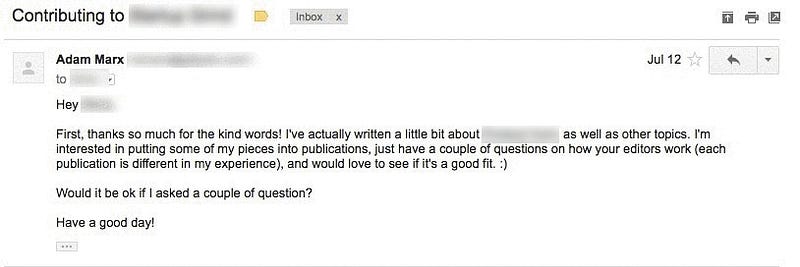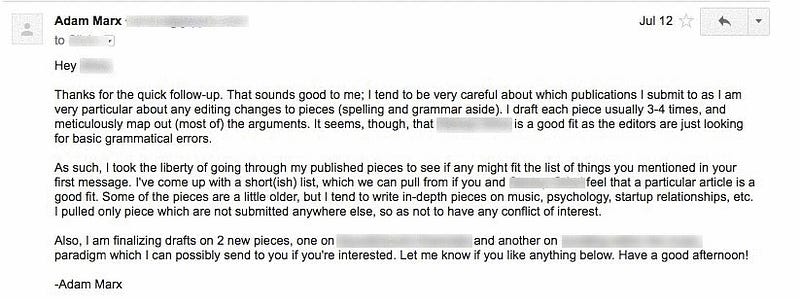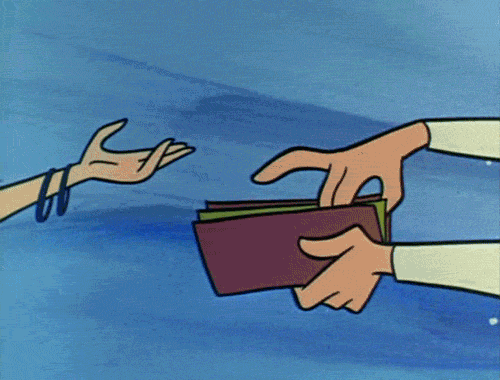How thinking like an editor can bullet-proof your writing.
Originally published on my Medium on December 2, 2016.

I come from a family of writers. My parents are both attorneys, and I spent my formative years in school learning how to write bullet-proof essays. It wasn’t until long after college, though, that I really began to see writing in more lights than simply as “a writer.” In fact, it was only recently that I’ve been able to think and write like an editor.
If you look around the blogosphere, and on Medium in particular, you see a lot of the same stuff. Not the same topics per se, but the same issues with the writing. A lot of it’s choppy, half-baked, passionate but not convincing, and many times riddled with grammatical mistakes. A lot of this can be avoided though.
A lot of time people see writing as a number of things — none of them good. They see it as tedious, superfluous, nonchalant, boring, or easy.
Writing is not easy, and writing on a higher level than “just writing” is a skill which takes constant practice and dedication. But for time-sake, here’s a crash-course to make your writing tighter, stronger, and all around better.
(Note: This won’t cover non-writing aesthetic choices, like pictures, gifs, videos, etc. This is focused solely on the art of writing and editing.)
Here’s a quick rundown:
- Grammar
- Spelling
- Tenses
- Formatting
- Thesis
- Argument
- Length
- Style

Grammar
Let’s get this one out of the way early. Poor spelling and grammar will kill any piece you write. Every time. Without fail. Don’t think you’re fooling anyone — we can all tell when you’re too lazy to proofread your article for mistakes. Learn to love multiple drafts.
So Rule #1 in writing like an editor: edit your damn article.
Caveat: I’ll cover this more in Style, but keep in mind that sometimes the most readable pieces aren’t necessarily the ones that follow 100% of grammar rules. This took me a long time to learn and become comfortable with. Be at ease using contractions, beginning sentences with “and” and “but,” and using slang terms like “gonna,” “bullshit,” and “fuck.” This gives your writing personality and makes it much less stilted. Just remember not to go overboard with things. If it doesn’t serve your argument, don’t fuck around with it.
Rule #1: Edit your damn article.
Spelling
We live in the era of spell-check. There’s literally no reason for spelling mistakes. If you don’t care enough to use spell-check, I don’t care enough to read it, end of story.
Tenses
This usually falls under grammar, but it’s important to break it out here. A lot of people seem to have problems with tensing, even some of the smartest, most insightful writers I enjoy reading (including hyper-successful founders, investors, marketers, etc.). It’s something people stumble over when it doesn’t make sense, and a lot of times it’s hard to pinpoint.
The best advice for keeping proper tensing is to read the wonky sentence out loud and see if it flows. If you’re having trouble with it, your readers will too. It should flow easily off the tongue, and if not, reexamine your tenses.
Formatting
Like grammar and tenses, formatting is one of those things you’ll need to take a step back on and read through an editor’s eyes. It’s one of the most tedious parts of editing, but one of the things that sets good pieces apart from complete crap.
Look and Feel: First, does it look good? If it’s blocky and hard to read, chances are people will never read it (unless you’re maybe already famous). Break things up — the “new paragraph” is your friend.
Italics, bold, and underline are essential to making something interesting to the eye, but don’t overdo it. Too much bold and you’re shouting at me; too many italics and you’re making me read a French pastry recipe.
ALL CAPS: Like bold, all caps is akin to yelling at me. Try to stay away from this. However, if you’re going to yell at me, make it count. Do it only if you really need to.

Bullet-points: Learn to love bullet-points, but don’t go overboard. Unless it’s an article that’s meant to be mostly in list-form, don’t overdo it. Not everything has to be bulleted — I’m reading your article, not your grocery list.
Punctuation: Vary your punctuation (more on this in Style). Learn the difference between a hyphen (-) and a dash ( — ), and when to use them to break up your text.
Rule: Hyphens are for combining words (like punk-rock) while dashes are used to break sentences (see 3rd paragraph of introduction).
Quotes: Ok, say it with me now: Double quotes (“ ”) are for the beginning/end of any quotation, while single quotes (‘ ’) are for a quotation within a quotation. That means if you’re quoting an article in which the article is quoting something or someone else, you need both. Also learn when to use block-quoting as opposed to singular, smaller quotes (Medium has thankfully made this much easier for people to understand and use).
Colons and Semi-colons: For fuck-sake, do not use colons or semi-colons if you’re not 100% clear on how to do it. Your writing won’t suffer much — if at all — if you leave them out. It will suffer A LOT if you put them in and don’t know how to use them. Stick to what you know and don’t try to over-impress your reader.
For the record though: Colons usually break a sentence right before you list something, or move to a clause or phrase which is meant to clarify the previous clause or phrase.
Semi-colons break a sentence and separate two independent clauses which tackle the same thought.
[Brackets]: Last thing, but very important. Brackets are used to tell your reader that you’re changing something from the original quote, but more for formatting, aesthetic, or clarification reasons. For example, if you’re simply changing the tenses of a word from singular to multiple, just put the “s” in brackets so I know you’re making a minor edit.
Like this: “Kurt Cobain drew influence[s] from his favorite album[s] when writing the follow-up to Nirvana’s second album.”
Remember: [Brackets] are not the same as (parentheses)!!
Thesis
This is the “idea” we all learned about in 3rd grade that “goes at the end of your first paragraph.” Except that’s bullshit, and much too simple.
Your thesis is your main concept, but isn’t necessarily your “argument” (see next point) and doesn’t necessarily need to come at the end of your first paragraph. It goes wherever it fits best, though this is usually towards the top of your article.
The thing to remember about your thesis is that it’s your broad topical concept, which means it’s flexible. Flexibility is good. Don’t feel shackled to a boring, hyper-specific point. If broad works better for the sake of your piece, then go broad, and get more specific in your argument.
This is how you write like an editor: accept that flexibility is a good thing, and that there is no 1, 2, 3-step process for plugging in pieces to make a good essay. Experiment, beginning with your thesis.
Argument
I see this a lot as an editor. People confuse their thesis with their argument. They are not the same thing. Your thesis is the concept or topic you’re going to tackle; you’re argument is how you hammer your points home.
Do not, for the love of God, use the 5-paragraph essay format unless it fits your topic and article. This is meant to be a learning tool, not something you do when you actually start writing complex pieces. It’s too constraining, and makes people put in (or leave out) points depending on how many spots they have left between their intro and conclusion. Again, writing is about flexibility, not rigidity.
Here’s the big secret: make your argument fucking bullet-proof. Take a side, and pound your theory home. You don’t need to be a jerk about it, but hedging your bets and sitting on the fence is a very tough thing to do right, and takes a ton of practice. And even then, it’s really only good in certain situations.
If I can drive a truck through holes in your argument, reexamine it. Leave some flexibility for yourself so you don’t back yourself into a corner, but make your argument solid. (Hint: this is where you use all those wonderful quotes, links, and examples we’re all so fond of).
Length
This is something that’s become somewhat taboo in our bite-sized, bloggish culture. The concept of writing anything long is considered “old” and “ramble-y.” Posts that appear “too long” are labeled “tl;dr” and relegated to the bottom of the pile.
But the reality is that some pieces should be longer. Or not. It all depends on the article and what you’re writing about.
If you’re just giving me a list of things (ideas, tips, etc.), then let me know at the beginning that it’s a listicle. If it’s just a fleeting thought to consider, don’t gear me up at the beginning for a long thought-piece, otherwise when you end abruptly, it feels like the bottom has just dropped out.
But if it’s a topic and argument that demands a long-form length, then be damn sure you give the piece what it requires. Trying to squeeze too much into a bite-sized article is a sure-fire way to tell your readers you have no idea how to articulate what you want to say. There’s a reason that publications like The New Yorker specialize in long-form content: they know how to flesh out an argument, and how to do it well.
Cut, Cut, Cut
Be willing to cut. Sometimes less is more. Be honest with yourself: if those extra two paragraphs don’t serve your argument or style, kick ’em to the curb. Learn to love deleting extra junk. There’s nothing as paralyzing as “blank-page” syndrome, but there’s nothing more unsightly than flabby content that serves no purpose. If you write 3 pages and delete everything except for the 1 paragraph that’s exceptional, it’s a good day.
Understanding length and how to use it to your advantage is equally as important as understanding how to format to your advantage.
Style
Now we’ve finally come to the most important thing no one tells you about and everyone forgets about: your style is everything. It took working as an editor for me to understand that everyone has a unique style, and that’s what makes someone’s writing compelling — or boring.
Writing like an editor means understanding what style works for you, and really flexing your creative muscles with it. It means exploring the types of slang that make your writing your own, what types of structure you totally own, and what topics are in your wheelhouse. If you’re an expert in something, write like you are. If you know you’re not, then proceed more gingerly and don’t try to pretend you’re something that you’re not.
Use punctuation that you’re a master at; there’s no “learning on the job” when it comes to punctuation. Poorly chosen punctuation can absolutely kill a piece with potential.
The reader can always tell.
The irony is, the more you write about something, the more you know about it, and the more you begin to develop original thoughts on it.
Your voice is your own, and is the one thing you have complete control over. Understand that voices change and evolve over time — your early writing will look a lot different from your more mature pieces. This is a good thing. Learn to isolate what makes your writing voice special without getting bogged down in the past. Once you have it, run with it.
And that’s about it, for the moment.
And that’s about it, for the moment. I could tackle tons of other topics like introductions, conclusions, transitions, titles, citations, or writing a series of pieces, but I think I’ll save those for another day. The important thing to remember is that writing is a process. One and done isn’t how to play the game.
If you’re going to write something, get in the trenches and get dirty. Don’t make me read some half-hearted piece of crap if you don’t have anything real to say. The hard part is knowing what’s real enough to write about, so I’ll leave that up to you.
Find me on Twitter and let’s talk tech, writing, and music!




































